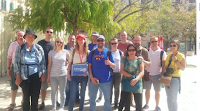
Yesterday we took a tour to
Gibraltar which is about 137 km (85 miles) from
Málaga.
Overall it's pretty tiny as it only covers 6,7 km² (2,6 sq miles) and 40% of the land area has been declared a nature reserve since 1993.
 Gibraltar
Gibraltar has a 1,2 km (0,75 mile) land border with
Spain. As it's part of the
UK, which isn't in
Schengen, you have to go through passport control to enter when coming from
Andalusia.
We knew we were in the UK because as soon as we arrived it started to rain. Fortunately it didn't last.

The Rock of Gibraltar is 426 metres (1,398 feet) high and is made out of Jurassic limestone. The rock has lots of tunnelled roads but most are closed to the public as they are used by the military.

Europa Point is Gibraltar's southernmost point and on a clear day you can can see
Morocco across the Strait of Gibraltar. The lighthouse began operating in 1841.

The Ibrahim-al-Ibrahim Mosque was a gift from King Fahd of Saudi Arabia. It cost around £5 million and opened in 1997.

The Great Siege Tunnels were dug out by the British at the end of the 18th century during the Great Siege of Gibraltar. They were used during WWII and tours are available.

St. Michael's Cave is a network of over 150 limestone caves about 300 metres (980 feet) above sea level. Cathedral Cave is the largest chamber and was converted to an auditorium.

The cable car was built in 1966. It takes people from the base to midway up the rock, the the Ape's Den, in about six minutes.

The most famous residents on the rock are the 300 Barbary macaques. They aren't scared of people and will get in to a bit of mischief if you aren't careful.

Main Street is the main business and shopping district. It's only 1 km (0,6 mile) so it's quite an easy stroll.

The Convent was once a convent of Franciscan friars built in 1531. Since 1728 it has been the official residence of the Governor of Gibraltar.

The Royal Gibraltar Regiment overseas defence. The unit was formed in 1958.

Built in 1817, and previously used as a library, the building was reopened in 1969 as the House of Assembly. In 2006 the House of Assembly was renamed parliament.

Here's Gibraltar's city hall. The building was originally a private mansion built in 1819.

The Cathedral of Saint Mary the Crowned was consecrated in 1462. It is Gibraltar's oldest Roman Catholic church.

King's Chapel was built in the 1530s and given to the Church of England in 1704.

The Great Synagogue was founded in 1724. It was the first synagogue on the Iberian Peninsula since Jews were expelled from Spain and
Portugal back in 1492 and 1497 respectively.

The Cathedral of the Holy Trinity was founded in 1838. It belongs to the Church of England.

The Naval Monument was built by the Americans in 1937 as a WWI memorial commemorating the UK and USA's joint efforts during the war. In 1998, a bronze plaque was added to commemorate the Allied invasion of North Africa in WWII.

King's Bastion used to defend Gibraltar during the Great Siege. In 2008, it was repurposed as a leisure centre with cinemas, ice skating, bowling, and a fitness centre.
Gibraltar was a great day trip and highly recommended. Although we did have a bit of a downpour when we first arrived, followed by heavy hail, it did clear up and turn out to be a beautiful day.
That fickle UK weather I guess.






























